|
||||||||||
|
|
||||||||||
|
||||||||||
|
|
||||||||||
Stopping an aircraft during the early days of aviation was not all that difficult. Even through World War II, most aircraft were relatively small and landed at low enough speeds that simple brakes, comparable to those on an automobile, were sufficient to stop a plane in a reasonable distance. It is true that the brakes used in aviation were generally more advanced than those used in the auto industry--disk brakes were first used on an airplane around 1910 while they did not become common on cars until the 1950s--but the basic concept was simple enough.

However, the advent of the jet engine ushered in a new era of much larger and faster aircraft for both the military and airline operations. Though wheel brakes were still used on these aircraft, they proved unable to bring modern planes to a stop without incredibly long runways. This behavior made it necessary to develop new mechanisms to create drag that overcomes the kinetic energy of a landing aircraft and reduces the landing roll. The concepts for doing so generally fall into two categories, aerodynamic devices and propulsive devices.
The two primary aerodynamic devices that have been used to increase drag on a plane during landing are control surfaces and parachutes. Some control surfaces, like the speed brake shown on the Su-27 below, are designed primarily for this purpose.
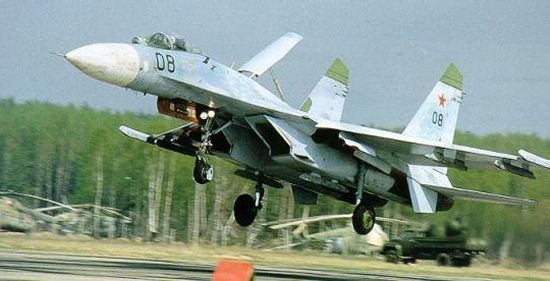
Other devices serve multiple purposes depending on how they are used during the course of a flight. Most commercial airliners are equipped with wing spoilers that are used to make banking turns. These devices are used during flight when the spoiler on one wing is deployed causing the plane to go into a bank. However, the devices can also be deflected on both wings simultaneously during landing. This use of spoilers creates an equal amount of drag on both sides of the plane that helps to slow the vehicle down and reduce the landing roll. A similar device is the drag rudder used on planes like the B-2 Spirit. Drag rudders are located near the wingtips and are also used primarily to help the plane turn during flight. Deflecting the rudders together during landing, however, creates aerodynamic drag to slow the plane down.

Another aerodynamic device that is less commonly used is the drag parachute. These parachutes are typically used only on military aircraft, although some Russian commercial airliners have actually used them as well. The Space Shuttle is also equipped with a parachute. During landing, one or more parachutes are deployed from a compartment in the aft end of an aircraft to increase the drag of the vehicle and provide additional stopping force. The primary disadvantage of this approach is that the parachute must be repackaged aboard the plane before the aircraft can take off again on its next flight.
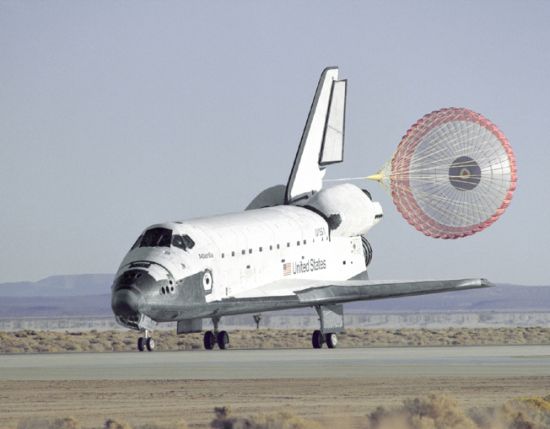
In addition to brakes and aerodynamic devices, an airplane's engines can also be used to help bring the vehicle to a stop. Many aircraft that generate thrust using propellers, whether they be powered by piston or turboprop engines, use variable pitch propeller blades. These blades can be rotated to different positions during flight to maximize their efficiency in producing thrust. In addition, the blades can be rotated to a position that creates high drag during landing to slow the aircraft.
A comparable device on jet-powered planes is called the thrust reverser. One common misconception about thrust reversing is that the engine itself actually runs in reverse, but this is not the case. In other words, air does not come in through the nozzle of the engine and be exhausted through the inlet to "reverse" the thrust. The engine itself still operates in the same manner, but the thrust it generates is redirected to produce drag. A number of different ways exist to reverse the thrust of both turbojet and turbofan engines, but they generally fall into two categories. These two methods are called cascades and clam shells, both of which are shown below on a conceptual schematic of a turbofan engine.

A cascade is basically a series of vanes that turns the air and directs it in a new direction. The cascade is built into the side of the engine nacelle and covered by a hinging or sliding door. When the door opens, it blocks off the flow of air through the engine and instead turns that air outward and forward to reverse its direction. This action turns the thrust into drag that resists the forward motion of the aircraft.
Cascades can be used both on the cool bypass air passing through the fan section of a turbofan and on the hot exhaust gases passing through the nozzle of a turbojet or turbofan. They are quite common on commercial airliners like the Boeing 737, DC-8, and L-1011 since cascades can be easily integrated into conventional engine nacelles. Cascades are also used on large military transport planes like the C-17 Globemaster III.
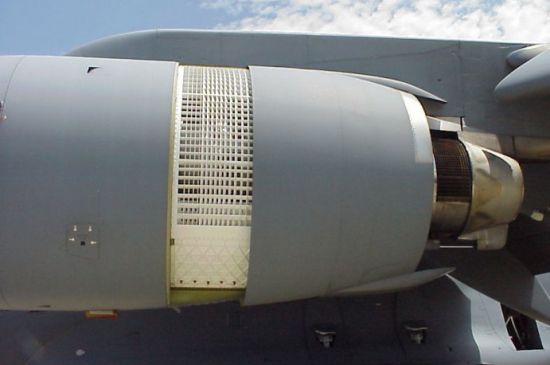
While cascades are more often used to redirect the flow through the bypass fan, a clam shell reverses the flow through the nozzle of a turbofan or turbojet engine. In this design, the outer nozzle wall is broken into two pieces. These pieces split apart and rotate backward to form a cone that deflects the airflow outward, as illustrated below.
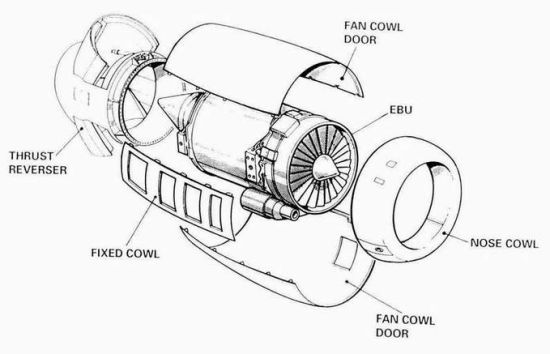
Clam shell thrust reversing nozzles are also frequently used on both military and civilian aircraft. An example of a common design is that used on the DC-9 pictured below.
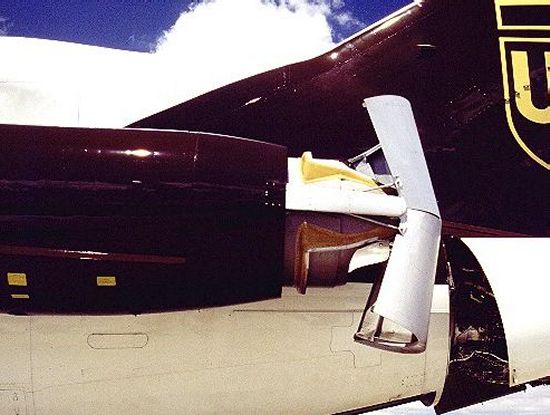
Most modern jet-powered airplanes equipped with thrust reversers use cascades, clam shells, or a mixture of the two. The exact configuration varies depending on the engine design, the placement of the engine, and the bypass ratio. Thrust reversers are usually only operated during landing. They are deployed just after touchdown and remain in operation until some minimum speed is reached. Below this speed, the danger of the hot exhaust gases being reingested, or pulled back into the engine, is too high. Both the exhaust gas and foreign debris could damage the engine, so the thrust reversers are closed at low speeds to prevent ingestion. On most aircraft, the thrust reversers are retracted once the plane slows below 70 mph (115 km/h).
Sandeep also asks about whether thrust reversers can be used during flight. One could never use such devices to fly backward since neither fixed wing aircraft nor their engines are designed to do so in the first place. Many problems would be encountered when attempting to fly in reverse, some of which are wing stall, engine flameout, and loss of control surface responsiveness.
Nevertheless, one interesting sidebar concerns research in using thrust reversers during flight to improve maneuverability. The idea was originally proposed by the US Navy as a way to better control the glide path during landings aboard aircraft carriers. Navy pilots of the 1950s were finding that the engines on their early jet aircraft were too slow in responding to the subtle changes in throttle required during carrier landings. It was hoped that an in-flight thrust reversing system would provide a faster response while maintaining the same engine revolutions per minute. NASA took charge of the study and conducted flight tests using a modified F-94C Starfire.

Additional tests were conducted for the Air Force, airline pilots, and the Federal Aviation Administration using F-104 Starfighter, CV-990, and DC-8 test planes. This research continued through the mid-1970s and proved that thrust reversers could be used to provide a very steep and rapid descent to follow a desired flight path.
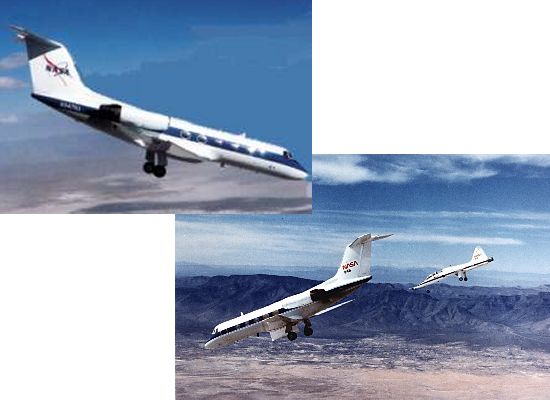
The only planes that appear to have ever used this technique operationally are NASA's Shuttle Training Aircraft
(STA). These planes are Gulfstream II business jets modified to simulate the landing characteristics of the Space
Shuttle and used to train astronauts. In order to approximate the high descent rate of the Shuttle, the
Gulfstreams pitch nose down into a 20° glideslope with the main landing gear down and thrust reversers deployed.
This configuration creates very high drag and gives the STA a rate of descent around 14,000 ft/min (4,265 m/min)
while maintaining a 300 knot dive. A Shuttle astronaut will have flown at least 500 of these simulated landings
aboard the STA by the time he or she makes the first trip into space.
- answer by Jeff Scott, 20 June 2004
Read More Articles:


|
Aircraft | Design | Ask Us | Shop | Search |

|
|
| About Us | Contact Us | Copyright © 1997- | |||
|
|
|||